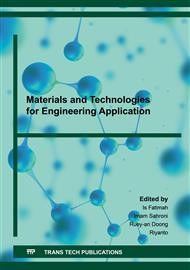p.87
p.93
p.101
p.109
p.119
p.129
p.137
p.144
p.151
Fabrication of Propolis Self-Nano Emulsfying Using Virgin Coconut Oil as Lipid-Based Vehicle
Abstract:
Propolis is a poorly water-soluble substance contain natural resinous produced by honey bees. Self-nanoemulsifying (SNE) play a role not only to increase the solubility of propolis but also to improve the pharmacological activity. The aim of the present study is to fabrication and characterization self-nanoemulsifying of propolis extract (SNEPE) using virgin coconut oil (VCO) as the lipid-based vehicle. VCO (lipid-based), cremophor RH 40 (surfactant) and polyethylene glycol (PEG) 400 with concentration 10-50; 10-80; 10-40% respectively was used to construction pseudo ternary phase diagram. The formulations that selected in the pseudo ternary phase diagram is continued for the fabrication of SNEPE. The formation of SNEPE was characterized include transmittance, particle size, zeta potential, thermodynamic stability test, robustness to dilution test, and accelerated stability test. The result showed that eight formulas using 10-20% of VCO, 40-80% of cremophor RH40, and 10-40% of PEG 400 were selected for the fabrication of SNEPE. SNEPE demonstrated the transmittance more than 90%, particle size with range 9,00±0,00 to 34,10±0,30 nm, and less than-30 mV of zeta potential. The formulation passed the thermodynamic stability test. The robustness to dilution test showed that three formulas with a ratio of 20: 70: 10, 20: 60: 20, and 20: 50: 30 are the most stable formulations in various dilution. The formulas are also stable during accelerated stability study. The results can be concluded that VCO, cremophor RH40, and PEG 400 as a vehicle to produce stable SNEPE.
Info:
Periodical:
Pages:
119-128
Citation:
Online since:
April 2021
Authors:
Keywords:
Price:
Сopyright:
© 2021 Trans Tech Publications Ltd. All Rights Reserved
Share:
Citation:


